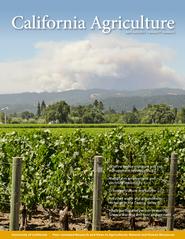All Issues

Smoke from the 2014 Butts Fire hovers over vineyards in Napa Valley. In recent years, wildfires in California have had far-reaching impacts on viticulture and the wine industry at large. Researchers surveyed wine grape growers and producers across the state to better understand how wildfires have affected viticulture and operational management decisions (see Zakowski et al., page 40). Photo: tfoxfoto, iStock.com.
Volume 77, Number 2





